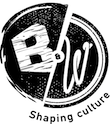3) List of Materials
You will need quite a few tools and materials. Some are absolutely necessary and others just make your life easier or simply promise a better result.
First, you need a list of materials that you'll require to construct the board. Then, a list of disposable materials, which will gradually expand. Finally, a list of tools that you'll need and a sub-list of tools that you might find yourself lacking.
The basic materials:
1. A piece of EPS with the density of our choice
2. Two component epoxy resin and possibly some pigment or dye
3. Fiberglass and possibly other types of fabrics
4, PVC sheets or wood in the form of veneer
5. Mast box, fin box and footstraps inserts
6. Paint, lacquers, anti-skid powder
7. EVA for the pads
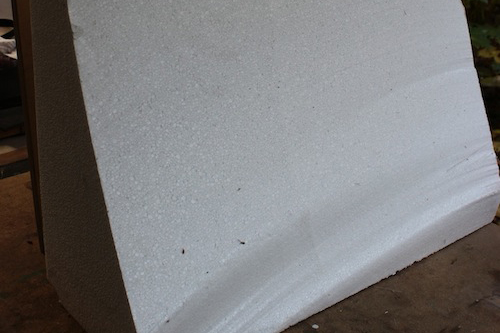 EPS (Expanded PolyStyrene):
EPS (Expanded PolyStyrene):
Commonly known as styrofoam or expanded polystyrene, EPS is available in various densities. It constitutes the core of the board and the largest part of its volume. An excellent material indeed, since it is super light and can easily be shaped. Its disadvantages are its weak durability and hydrophilicity. A good market research is worth it, as prices vary greatly.
Epoxy Resin:
A glue of two components which when mixed at the required proportions, allows a time window 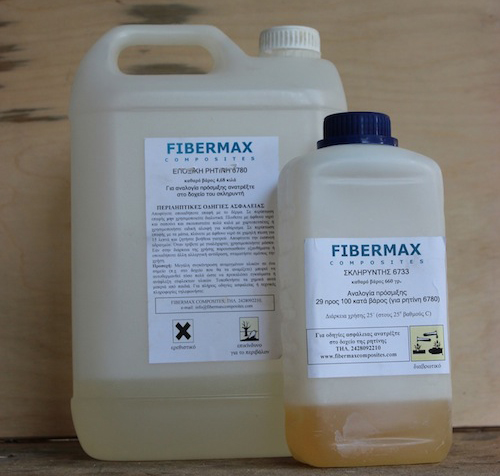 for processing before it begins to cure. By choosing an epoxy system, we need to take into account the cost, the processing time, and the time frame for full hardening, and the system' s requirements for curing and post curing. Also, the properties of the final product, such as, its durability to UV radiation, salt water environment and temperatures of intense sunshine. You should also take into consideration the rate at which heat is released, as a high rate could affect the EPS negatively at the first stages of construction. In addition, you could add a paint to the epoxy resin mix. This will make it easier to ascertain the adequate filling of the fiberglass on the white EPS background but will also help when giving the board its final finish. Note: add only the permitted mixing ratio.
for processing before it begins to cure. By choosing an epoxy system, we need to take into account the cost, the processing time, and the time frame for full hardening, and the system' s requirements for curing and post curing. Also, the properties of the final product, such as, its durability to UV radiation, salt water environment and temperatures of intense sunshine. You should also take into consideration the rate at which heat is released, as a high rate could affect the EPS negatively at the first stages of construction. In addition, you could add a paint to the epoxy resin mix. This will make it easier to ascertain the adequate filling of the fiberglass on the white EPS background but will also help when giving the board its final finish. Note: add only the permitted mixing ratio.
Fabrics:
Fabrics are the basic structural material for any board. 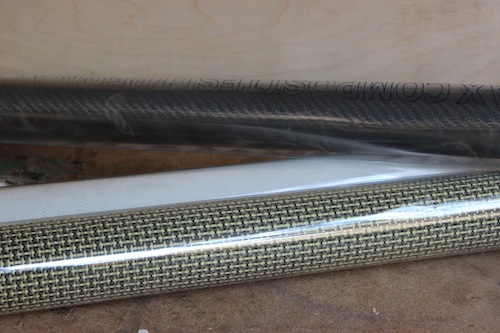 Many manufacturers use the term "sandwich" and the fiberglass (or other fabrics) filled with epoxy resin play the role of the "bread". A core material like PVC, EPS, or wood -all with their advantages and disadvantages- acts as the "ham". In the process of choosing fabrics, attention must be paid to their weight, their strand and their properties, which ensure different characteristics both during the process of covering and in the final result. There is a variety of fabrics available with a range of properties and cost - carbon, carbon-aramid, dyneema and innegra-carbon being some of the most well-known ones.
Many manufacturers use the term "sandwich" and the fiberglass (or other fabrics) filled with epoxy resin play the role of the "bread". A core material like PVC, EPS, or wood -all with their advantages and disadvantages- acts as the "ham". In the process of choosing fabrics, attention must be paid to their weight, their strand and their properties, which ensure different characteristics both during the process of covering and in the final result. There is a variety of fabrics available with a range of properties and cost - carbon, carbon-aramid, dyneema and innegra-carbon being some of the most well-known ones.
PVC foam or wood veneer:
The cell foam of polyvinyl chloride is a fascinating material which can be found in sheets of various densities.  Super light for its cohesion, hydrophobic and flexible, it plays the part of the "ham" in any sandwich board that respects itself. The disadvantages are its high cost and the difficulty of fitting it perfectly to curved surfaces. Instead of PVC sheets, you can use wood veneer with less notable characteristics but exceptional appearance! Finally, in some cases, the part of the "ham" is played by an EPS sheet with disputable effects when it comes to the endurance of the board but great results as far as your pocket is concerned.
Super light for its cohesion, hydrophobic and flexible, it plays the part of the "ham" in any sandwich board that respects itself. The disadvantages are its high cost and the difficulty of fitting it perfectly to curved surfaces. Instead of PVC sheets, you can use wood veneer with less notable characteristics but exceptional appearance! Finally, in some cases, the part of the "ham" is played by an EPS sheet with disputable effects when it comes to the endurance of the board but great results as far as your pocket is concerned.
Other "core" materials are also available in the market, such as, coremat and honeycomb, which however, are not often used for windsurf boards.
Inserts:
After completing the lamination with much toil and sweat we need to aggressively drill the board to place the inserts. 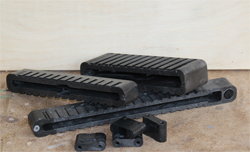 By inserts we mean the mast track box, the fin box and the plugs on which the footstraps are screwed. We will not have trouble choosing between products, as the only affordable and at the same time reliable ones are those of the Chinook brand. Short or long mast tracks, plugs with one, two, four or five holes and fin boxes of various types and sizes should be chosen according to the specifications of the board we want to construct. The way in which the inserts will be reinforced when placing them inside the board, is of great importance. There are several ways:
By inserts we mean the mast track box, the fin box and the plugs on which the footstraps are screwed. We will not have trouble choosing between products, as the only affordable and at the same time reliable ones are those of the Chinook brand. Short or long mast tracks, plugs with one, two, four or five holes and fin boxes of various types and sizes should be chosen according to the specifications of the board we want to construct. The way in which the inserts will be reinforced when placing them inside the board, is of great importance. There are several ways:
a) Before starting the lamination process, "bricks" of polyurethane are placed in the positions intended for the inserts.
b) After drilling the holes for the inserts, we reinforce them with PVC sheets.
c) Reinforcing the boxes themselves with PVC sheets.
d) Other ways
Paints, lacquers, anti-skid powder:
Paints and CHAOS! 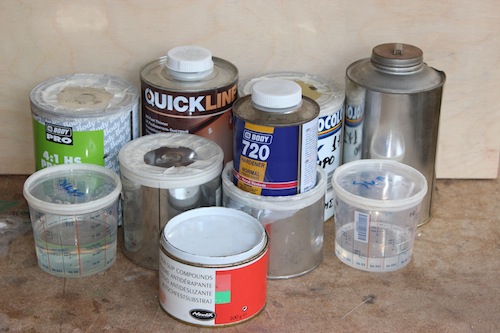 Dozens of choices between acrylics, epoxics and polyurethanic, of one or two composites, with advantages, disadvantages and a permanent high cost, both financial and in terms of weight and of significant safety requirements during their use. A similar situation applies to lacquers! A personal acquaintance with expertise in this field or a supplier eager to explain the "hows" and "whys" of every type of product would be the best solution. The anti-skid powder is simply acrylic powder which can easily be found in maritime supply stores in various qualities and grain sizes. There are several ways to apply it, all of which are rather simple.
Dozens of choices between acrylics, epoxics and polyurethanic, of one or two composites, with advantages, disadvantages and a permanent high cost, both financial and in terms of weight and of significant safety requirements during their use. A similar situation applies to lacquers! A personal acquaintance with expertise in this field or a supplier eager to explain the "hows" and "whys" of every type of product would be the best solution. The anti-skid powder is simply acrylic powder which can easily be found in maritime supply stores in various qualities and grain sizes. There are several ways to apply it, all of which are rather simple.
EVA for the pads:
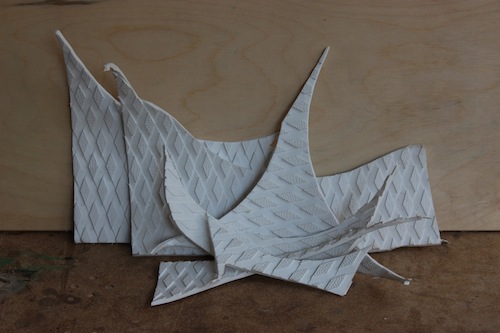 The EVA is another brilliant material that affects the perforance and the feeling of our board. It is a foamy, rubbery material which maintains its flexibility for a long time, reverting its original shape despite our frantic stepping on it! If we buy a striped one from a windsurf equipment store it will be quite expensive. If we get one from an industrial supplier, the price will be considerably lower but we need to find a way to create some kind of "anti-skid" engraving.
The EVA is another brilliant material that affects the perforance and the feeling of our board. It is a foamy, rubbery material which maintains its flexibility for a long time, reverting its original shape despite our frantic stepping on it! If we buy a striped one from a windsurf equipment store it will be quite expensive. If we get one from an industrial supplier, the price will be considerably lower but we need to find a way to create some kind of "anti-skid" engraving.
Page:
Previous > 0 > 1 > 2 > 3 > 4 > 5 > 6 > 7 > 8 > Next
www.boardsNwheels.gr > English version > How to > Buillding a custom windsurf board

